Scientists from Harvard University have created a system, dubbed the ‘bionic leaf’, that splits water molecules into its base hydrogen and oxygen atoms, then uses bacteria to create a liquid fuel, called isopropanol, a versatile fuel that can be used as a propellant. The way it works it after a synthetic leaf splits the water into hydrogen and oxygen, the hydrogen is fed to a bacteria, which then combines the hydrogen with carbon dioxide to make isopropanol. Scientists still need to up the efficiency of their new bionic system, but the findings could lead to greater energy independence for those in developing nations.

Bacteria creates fuel from sunlight
More of Today's Solutions
How citizen scientists are driving tangible change in Australia
Citizen science has evolved as a formidable force in conservation, propelled by regular people's passion and dedication to conserving our planet's irreplaceable ecosystems. Citizen ...
Read MoreMeet Dr. Wade: writer of thousands of Wikipedia pages for women scientists
Though the world has made some strides in gender equality, there is certainly still room for improvement, especially in the field of science, technology, ...
Read MoreArt preserves endangered flora in Himalayas—where conservation and culture co...
"In 2002, I was returning to Kalimpong in the eastern Himalaya region of India, and I found numerous trees had been cut down for ...
Read MorePrescribed thinning and controlled burns critical in preventing California wi...
A pioneering two-decade-long study done in California's Sierra Nevada mountains confirms the effectiveness of forest management strategies such as restorative thinning and regulated burning ...
Read More










